______________________________________________________________________
MONTANE
HABITATS
 Inland
from the narrow lowland belt that encircles Thásos lies a beautiful unspoilt
wilderness of mountain ridges, spectacular valleys, ancient pine forests and
limestone pavements. It is a truly magnificent landscape of great variety and
awe-inspiring views.
Inland
from the narrow lowland belt that encircles Thásos lies a beautiful unspoilt
wilderness of mountain ridges, spectacular valleys, ancient pine forests and
limestone pavements. It is a truly magnificent landscape of great variety and
awe-inspiring views.
Topographically
the island's interior is aligned along a series of south-west to north-east
ridges, culminating in the spectacular northern rim of Ipsarion Oros towering
above Potamia, Panagia and Thassos Town. The summit of the island is Ipsarion
itself at 1204 metres high but there are several impressive peaks along this
ridge, including Profitis Ilias (1110m), Dio Kefales (1030m), and Touba (1132m).
At the extremities of the Ipsarion range lie Ai-Matis (809m) above Skala Maries
in the south-west and Trikorfo (805m) above Thimonia in the south-east.
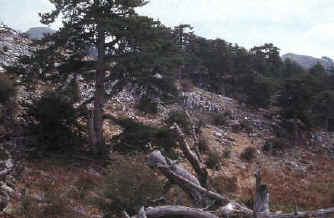 The
upland habitats consist of a mixture of woodland, scrub, grassland and bare rock
communities. Despite recent fires (which mainly affected lowland forests),
conifer woodlands dominate over much of the upland landscape. Here the species
involved is black pine Pinus nigra ssp. pallasiana, reaching almost to 1200m on Ipsarion,
although it is absent from the most exposed and rocky summits. On the highest ground, to the south-west
of Profitis Ilias for instance, the pines are
The
upland habitats consist of a mixture of woodland, scrub, grassland and bare rock
communities. Despite recent fires (which mainly affected lowland forests),
conifer woodlands dominate over much of the upland landscape. Here the species
involved is black pine Pinus nigra ssp. pallasiana, reaching almost to 1200m on Ipsarion,
although it is absent from the most exposed and rocky summits. On the highest ground, to the south-west
of Profitis Ilias for instance, the pines are
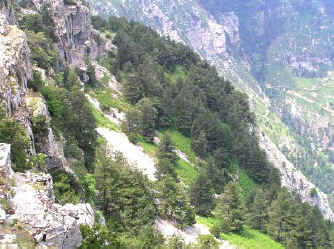 ancient and in places resemble the
'granny' pines of the Caledonian forests in the Scottish Highlands. These appear
even more remarkable when growing out of the high altitude limestone
pavements,
although many of these trees are now dead and there is little or no evidence of
regeneration. On the north-eastern flanks of Ipsarion is a remnant area of
silver fir forest Abies borisii-regis mixed with black
pine. This was reportedly burnt in the recent fires but it should still harbour
wildlife that is restricted to fir and hence is worthy of examination. Grazing by goats
has prevented the development of a understorey in most forest areas and beneath the
canopy is usually a mix of bracken and upland grassland. However, Cistus
phrygana extends surprisingly high up the mountains, with tree heath Erica
manipuliflora the dominant shrub.
ancient and in places resemble the
'granny' pines of the Caledonian forests in the Scottish Highlands. These appear
even more remarkable when growing out of the high altitude limestone
pavements,
although many of these trees are now dead and there is little or no evidence of
regeneration. On the north-eastern flanks of Ipsarion is a remnant area of
silver fir forest Abies borisii-regis mixed with black
pine. This was reportedly burnt in the recent fires but it should still harbour
wildlife that is restricted to fir and hence is worthy of examination. Grazing by goats
has prevented the development of a understorey in most forest areas and beneath the
canopy is usually a mix of bracken and upland grassland. However, Cistus
phrygana extends surprisingly high up the mountains, with tree heath Erica
manipuliflora the dominant shrub.
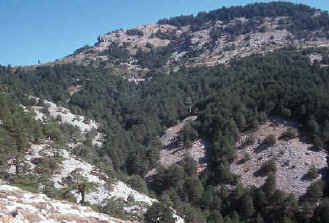 The
limestone pavements are widespread in the northern uplands, with vast tracts
extending between Profitis Ilias and Ipsarion, and there is also reported to be
an extensive area of pavement above the mountain village of Theologos in the
south. In spring and early summer the pavements are studded with colour,
including the beautiful mauve flowers of wild iris
The
limestone pavements are widespread in the northern uplands, with vast tracts
extending between Profitis Ilias and Ipsarion, and there is also reported to be
an extensive area of pavement above the mountain village of Theologos in the
south. In spring and early summer the pavements are studded with colour,
including the beautiful mauve flowers of wild iris
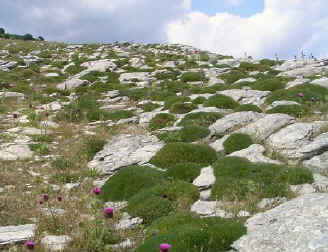 Iris suavolens, but
from mid summer onwards they are superficially barren apart from the
silvery tufts of Inula verbascifolia ssp. aschersoniana and occasional
ferns sheltering in the grykes. Clothing the slopes of the Mesonisi valley
alongside the main track up to Ipsarion from Maries is another massive area of
broken pavement. Here there are abundant spiny cushions of milk vetch Astragalus
angustifolius, patches of thyme Thymus sp., and clumps of Inula.
Another extensive area of this 'cushion' pavement occurs on Spitoudia, behind
the Mountain Refuge. Apart from
the track through to Profitis Ilias that bisects it, this pavement is
undisturbed and quite beautiful. This seems to be a unique habitat type on the island and worthy of further
botanical and entomological investigation.
Iris suavolens, but
from mid summer onwards they are superficially barren apart from the
silvery tufts of Inula verbascifolia ssp. aschersoniana and occasional
ferns sheltering in the grykes. Clothing the slopes of the Mesonisi valley
alongside the main track up to Ipsarion from Maries is another massive area of
broken pavement. Here there are abundant spiny cushions of milk vetch Astragalus
angustifolius, patches of thyme Thymus sp., and clumps of Inula.
Another extensive area of this 'cushion' pavement occurs on Spitoudia, behind
the Mountain Refuge. Apart from
the track through to Profitis Ilias that bisects it, this pavement is
undisturbed and quite beautiful. This seems to be a unique habitat type on the island and worthy of further
botanical and entomological investigation.
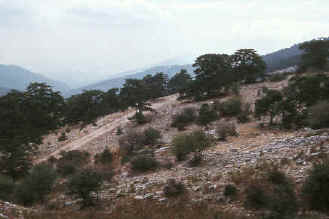 Where
slightly deeper soils permit the development of stands of vegetation in the open
there is a mixture of bracken Pteridium aquilinum, grassland and scrub.
Bracken stands are ubiquitous but substantial areas of upland pasture appear to
be localised and mainly confined to the ridges between summits. Presumably they
are very significant botanically but during my visits they have been parched,
with few flowers evident other than the splash of colour from the flowers of Crocus
pulchellus. These grasslands have an abundance of butterflies, including
Queen of Spain fritillary Issoria lathonia, lesser spotted fritillary Melitaea
trivia and brown argus Aricia agestis, and numerous grasshoppers. The scrub types are varied, with pockets of plane Platanus
orientalis and even alder occurring at surprisingly high altitudes, but
hawthorn Crataegus monogyna is most frequent along with prickly juniper
Juniperus
oxycedrus.
Where
slightly deeper soils permit the development of stands of vegetation in the open
there is a mixture of bracken Pteridium aquilinum, grassland and scrub.
Bracken stands are ubiquitous but substantial areas of upland pasture appear to
be localised and mainly confined to the ridges between summits. Presumably they
are very significant botanically but during my visits they have been parched,
with few flowers evident other than the splash of colour from the flowers of Crocus
pulchellus. These grasslands have an abundance of butterflies, including
Queen of Spain fritillary Issoria lathonia, lesser spotted fritillary Melitaea
trivia and brown argus Aricia agestis, and numerous grasshoppers. The scrub types are varied, with pockets of plane Platanus
orientalis and even alder occurring at surprisingly high altitudes, but
hawthorn Crataegus monogyna is most frequent along with prickly juniper
Juniperus
oxycedrus.
This very
superficial account of the broad habitat types occurring in the uplands on Thásos
probably omits some important examples and merely reflects my own experiences
during the few visits I have made. Now that access is much easier (see Maps)
more of the upland landscape has become accessible to visiting naturalists (and holidaymakers) and hence it is likely that many interesting
discoveries will be made in the future. I would be extremely pleased to hear of
any natural history observations in the Thásos uplands.






 Inland
from the narrow lowland belt that encircles Thásos lies a beautiful unspoilt
wilderness of mountain ridges, spectacular valleys, ancient pine forests and
limestone pavements. It is a truly magnificent landscape of great variety and
awe-inspiring views.
Inland
from the narrow lowland belt that encircles Thásos lies a beautiful unspoilt
wilderness of mountain ridges, spectacular valleys, ancient pine forests and
limestone pavements. It is a truly magnificent landscape of great variety and
awe-inspiring views. The
upland habitats consist of a mixture of woodland, scrub, grassland and bare rock
communities. Despite recent fires (which mainly affected lowland forests),
conifer woodlands dominate over much of the upland landscape. Here the species
involved is black pine Pinus nigra ssp. pallasiana, reaching almost to 1200m on Ipsarion,
although it is absent from the most exposed and rocky summits. On the highest ground, to the south-west
of Profitis Ilias for instance, the pines are
The
upland habitats consist of a mixture of woodland, scrub, grassland and bare rock
communities. Despite recent fires (which mainly affected lowland forests),
conifer woodlands dominate over much of the upland landscape. Here the species
involved is black pine Pinus nigra ssp. pallasiana, reaching almost to 1200m on Ipsarion,
although it is absent from the most exposed and rocky summits. On the highest ground, to the south-west
of Profitis Ilias for instance, the pines are
 ancient and in places resemble the
'granny' pines of the Caledonian forests in the Scottish Highlands. These appear
even more remarkable when growing out of the high altitude limestone
pavements,
although many of these trees are now dead and there is little or no evidence of
regeneration. On the north-eastern flanks of Ipsarion is a remnant area of
silver fir forest Abies borisii-regis mixed with black
pine. This was reportedly burnt in the recent fires but it should still harbour
wildlife that is restricted to fir and hence is worthy of examination. Grazing by goats
has prevented the development of a understorey in most forest areas and beneath the
canopy is usually a mix of bracken and upland grassland. However, Cistus
phrygana extends surprisingly high up the mountains, with tree heath Erica
manipuliflora the dominant shrub.
ancient and in places resemble the
'granny' pines of the Caledonian forests in the Scottish Highlands. These appear
even more remarkable when growing out of the high altitude limestone
pavements,
although many of these trees are now dead and there is little or no evidence of
regeneration. On the north-eastern flanks of Ipsarion is a remnant area of
silver fir forest Abies borisii-regis mixed with black
pine. This was reportedly burnt in the recent fires but it should still harbour
wildlife that is restricted to fir and hence is worthy of examination. Grazing by goats
has prevented the development of a understorey in most forest areas and beneath the
canopy is usually a mix of bracken and upland grassland. However, Cistus
phrygana extends surprisingly high up the mountains, with tree heath Erica
manipuliflora the dominant shrub.  The
limestone pavements are widespread in the northern uplands, with vast tracts
extending between Profitis Ilias and Ipsarion, and there is also reported to be
an extensive area of pavement above the mountain village of Theologos in the
south. In spring and early summer the pavements are studded with colour,
including the beautiful mauve flowers of wild iris
The
limestone pavements are widespread in the northern uplands, with vast tracts
extending between Profitis Ilias and Ipsarion, and there is also reported to be
an extensive area of pavement above the mountain village of Theologos in the
south. In spring and early summer the pavements are studded with colour,
including the beautiful mauve flowers of wild iris
 Iris suavolens, but
from mid summer onwards they are superficially barren apart from the
silvery tufts of
Iris suavolens, but
from mid summer onwards they are superficially barren apart from the
silvery tufts of  Where
slightly deeper soils permit the development of stands of vegetation in the open
there is a mixture of bracken Pteridium aquilinum, grassland and scrub.
Bracken stands are ubiquitous but substantial areas of upland pasture appear to
be localised and mainly confined to the ridges between summits. Presumably they
are very significant botanically but during my visits they have been parched,
with few flowers evident other than the splash of colour from the flowers of
Where
slightly deeper soils permit the development of stands of vegetation in the open
there is a mixture of bracken Pteridium aquilinum, grassland and scrub.
Bracken stands are ubiquitous but substantial areas of upland pasture appear to
be localised and mainly confined to the ridges between summits. Presumably they
are very significant botanically but during my visits they have been parched,
with few flowers evident other than the splash of colour from the flowers of 



